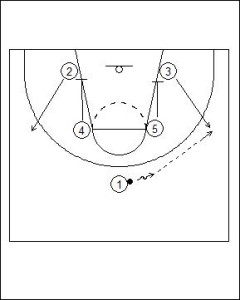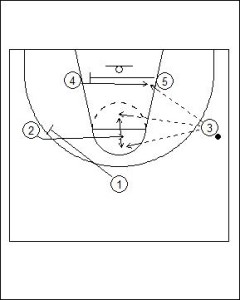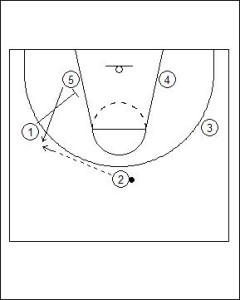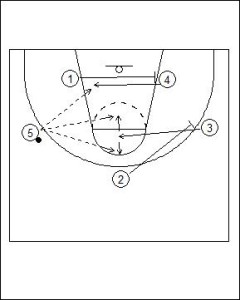3-2 Patterned Motion Offense
The 3-2 Patterned Motion Offense is another simple offense useful as a starting point for junior teams or as a basic offense upon which to build for senior teams. A patterned offense relies heavily on the strength of having an offense that players can continue to run until the defence makes an error. Patterned offenses are continuity offences and they can be run continuously from one of the floor to the other indefinitely.
The 3-2 Patterned Motion Offense is especially useful for junior teams who are starting out with learning a basketball offense. The benefits of this type of offense are further compounded for junior basketball teams by being more simplistic to learn. This is because the pattern of the offense is repeated so regularly that players find this situation significantly less difficult to understand and perform with a high degree of difficulty.
An additional benefit of using a patterned offense is once the initial pattern has been grasped by players then attention can turn to the technique and execution of the offense. Allowing for a greater degree of technical proficiency to be reached by the team with constant breakdowns and drilling being employed.
For senior teams the basic play pattern of the offense is useful as a starting put for more complex offensive options. The 3-2 Patterned Motion Offense provides the foundation on which additional options such as secondary transition plays or terminal sets can be added into to give a varied range of play options.
For beginner coaches the scenario of adding to an offence to develop a play into a system is something very frequently overlooked. Often the path of offense variation is based upon implementation completely different individual plays instead of building offensive principles into the existing offensive strategy currently being utilised. Different formations, cutting and screening options are all tactical elements which can be included into any offense with the right amount of thought and time.
The 3-2 Patterned Motion Offense formation is more preferable for teams which have two strong back to the basket post players. Initially this offence allows both players to start in the low post and have equal opportunity for a direct pass into the favoured scoring position.
The other benefit of a 3-2 Patterned Motion Offense compared to for example a 1-3-1 Patterned Motion Offense is it creates further space between defensive players in the middle of the floor. This means in the middle of the floor around the free-throw line there is greater space to cut into a receiving position. By starting the 3-2 formation this space also serves to facilitate possible flashing options for post players to fill and move between different offensive structures causing greater defensive issues.

The starting option shown here is out of a box formation but this can just as easily be starting the 3-2 Patterned Motion Offense formation without this set-up.
High post players (Four and Five) set screens for low post players (Two and Three).
Low post players cut off screens and head to 3/45 (Two and Three).
One (1) dribbles towards one side and passes ball.

Five (5) sets screen for weak side low post player (Four).
One (1) sets screen for weak side wing (Two).
Four (4) cuts over screen and moves towards low post.
Two (2) cuts over screen to free throw line.
Option 1: Three (3) passes ball to Four (4)
Option 2: Three (3) passes ball to Two (2)

Two (2) receives ball and moves to point position.
One (1) sets screen for Five (5).
Five (5) cuts under screen and into wing position where the ball is reversed to.
Two (2) passes ball to Five (5).
This particular play for the 3-2 Patterned Motion Offense allows strong post playing guards to work into scoring opportunities as well as bring tall defensive players away from the basket.
As a benefit a perimeter shooting interior player can also have scoring opportunities catered for. This also is of advantage if the interior player is significantly quicker off the dribble then their defensive match-up from the perimeter.

One (1) sets screen for Four (4).
Two (2) sets screen for Three (3).
Four (4) cuts over screen to opposite low block.
Three (3) cuts over screen and moves to free throw line.
Option 1: Five (5) passes ball to Four (4)
Option 2: Five (5) passes ball to Two (2)
The play continues to be repeated until good scoring opportunity is presented.







